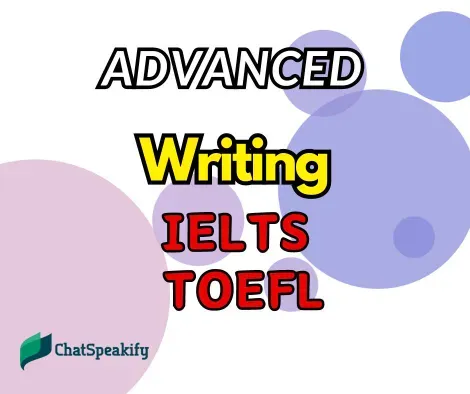In this lesson, we focus on advanced writing techniques that will elevate your performance in the IELTS and TOEFL exams. Mastering these strategies enhances the clarity, coherence, and sophistication of your writing, crucial for achieving high scores.
1. Using Cohesive Devices for Smooth Transitions
Cohesive devices are essential for connecting ideas and paragraphs, ensuring your writing flows smoothly from one point to the next.
Examples: “Moreover,” “therefore,” “however,” “in addition,” “for instance”
Example Sentence: The research is comprehensive; however, further studies are needed.
This example shows how “however” transitions the idea logically to emphasize the need for additional research.
2. Varying Sentence Structure for Interest
Employing a variety of sentence structures adds dynamism and engages readers more effectively.
Examples: Combine simple, compound, and complex sentences.
Example Sentence: She enjoys reading; her favorite books are mysteries, which she finds intriguing.
By varying sentence structures, you maintain reader interest and highlight different aspects of your writing.
3. Using Advanced Vocabulary for Precision
Advanced vocabulary enables precise expression of ideas, demonstrating a deeper understanding of the subject matter.
Examples: “Analyze,” “synthesize,” “elaborate,” “exemplify”
Example Sentence: She elaborated on her argument by providing multiple examples.
Using specific vocabulary enriches your writing, making it more nuanced and persuasive.
4. Employing Formal Tone for Academic Writing
A formal tone is essential in academic writing to convey professionalism and credibility.
Examples: Avoid contractions, use technical terms, and maintain objectivity.
Example Sentence: The results indicate a significant correlation between the variables.
Formal language enhances the authority of your arguments and ensures clarity in conveying complex ideas.
5. Structuring Essays with Clear Paragraphs
Well-structured essays with clear paragraph organization improve readability and coherence.
Examples: Start with a topic sentence, provide supporting details, and conclude with a summary.
Example Sentence: The introduction provides background information; the body paragraphs delve into detailed analysis.
Clear paragraph structure guides the reader through your ideas logically, enhancing comprehension and overall impact.
By incorporating these advanced writing techniques into your practice, you’ll not only improve your performance in exams like IELTS and TOEFL but also enhance your overall writing proficiency for academic and professional contexts.
Conclusion
These strategies form the foundation for advanced writing proficiency, ensuring your ideas are communicated effectively and convincingly. Practice these techniques to refine your skills and achieve success in your academic and professional pursuits.
